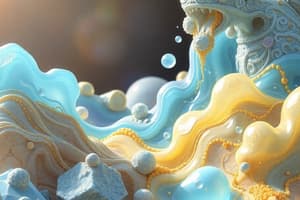Podcast
Questions and Answers
What primary benefit do ceramic reinforcements provide in PCMCs?
What primary benefit do ceramic reinforcements provide in PCMCs?
- Enhanced mechanical strength (correct)
- Reduced manufacturing cost
- Improved electrical conductivity
- Increased flexibility
Which of the following is NOT a characteristic of PCMCs?
Which of the following is NOT a characteristic of PCMCs?
- Low thermal stability (correct)
- High tensile strength
- Chemical resistance
- Tailorable properties
Which manufacturing technique is commonly used to shape PCMCs into complex geometries?
Which manufacturing technique is commonly used to shape PCMCs into complex geometries?
- Stamping
- Blow molding
- Electroforming
- Filament winding (correct)
What is one of the main applications of PCMCs in the aerospace industry?
What is one of the main applications of PCMCs in the aerospace industry?
Which type of PCMC features both polymer and ceramic phases interlocked at a microscopic level?
Which type of PCMC features both polymer and ceramic phases interlocked at a microscopic level?
What is a challenge associated with PCMCs?
What is a challenge associated with PCMCs?
Which of the following properties can be engineered in PCMCs depending on the components used?
Which of the following properties can be engineered in PCMCs depending on the components used?
What is a typical application of PCMCs in the electronics industry?
What is a typical application of PCMCs in the electronics industry?
Flashcards are hidden until you start studying
Study Notes
PCMCs (Polymer-Ceramic Matrix Composites)
-
Definition: PCMCs are composite materials combining polymers (organic materials) and ceramics (inorganic materials) to leverage the benefits of both.
-
Components:
- Polymer Matrix: Provides flexibility, toughness, and ease of processing.
- Ceramic Reinforcement: Enhances mechanical strength, thermal stability, and wear resistance.
-
Types of PCMCs:
- Reinforced PCMCs: Contain ceramic particles or fibers within a polymer matrix.
- Interpenetrating Networks: Feature both polymer and ceramic phases interlocked at a microscopic level.
-
Properties:
- Mechanical: High tensile strength and stiffness due to ceramic content.
- Thermal: Improved thermal stability compared to pure polymers; some can withstand high temperatures.
- Electrical: Can be engineered for electrical insulation or conductivity depending on the components used.
- Chemical Resistance: Generally more resistant to chemicals and solvents than pure polymers.
-
Manufacturing Techniques:
- Molding: Techniques such as injection or compression molding for shaping.
- Filament Winding: For creating complex geometries.
- Casting: Combining the materials in liquid form to allow for the uniform distribution of ceramics.
-
Applications:
- Aerospace: Lightweight components that require thermal resistance.
- Automotive: Parts that need high strength-to-weight ratios and wear resistance.
- Biomedical: Drug delivery systems and implants due to biocompatibility.
- Electronics: Insulators or substrates within electronic devices.
-
Advantages:
- Tailorable properties for specific applications.
- Lightweight yet strong materials.
- Enhanced durability and lifespan in demanding environments.
-
Challenges:
- Processing complexities due to the differences in thermal expansion and other properties of polymers and ceramics.
- Cost of high-performance ceramics can be prohibitive.
- Limited understanding of long-term behavior and aging under different conditions.
Definition and Components
- PCMCs combine polymers (organic) and ceramics (inorganic) to utilize the advantages of both materials.
- The polymer matrix imparts flexibility, toughness, and ease of processing.
- Ceramic reinforcement boosts mechanical strength, thermal stability, and wear resistance.
Types of PCMCs
- Reinforced PCMCs incorporate ceramic particles or fibers within the polymer matrix for enhanced properties.
- Interpenetrating networks feature intertwined polymer and ceramic phases at a microscopic level, maximizing performance.
Properties
- Mechanical properties include high tensile strength and stiffness attributed to the ceramic content.
- Thermal stability surpasses that of pure polymers; some PCMCs can endure high temperatures efficiently.
- Electrical properties can be tailored for either insulation or conductivity based on the material components.
- Chemical resistance is superior to that of pure polymers, offering better resilience to chemicals and solvents.
Manufacturing Techniques
- Molding methods like injection or compression molding are used to shape PCMCs.
- Filament winding allows for the creation of intricate geometries.
- Casting combines materials in liquid form, ensuring a uniform distribution of ceramics.
Applications
- Aerospace industry utilizes lightweight components that require excellent thermal resistance.
- Automotive sector benefits from parts that need high strength-to-weight ratios and wear resistance.
- Biomedical applications include drug delivery systems and implants due to their biocompatibility.
- Electronics leverage PCMCs for insulators or substrates in various devices.
Advantages
- Properties can be tailored to meet specific application needs.
- PCMCs are lightweight yet offer impressive strength.
- Enhanced durability and lifespan make them suitable for demanding environments.
Challenges
- Processing is complex due to disparities in thermal expansion and other properties between polymers and ceramics.
- The high cost of performance ceramics may limit widespread use.
- Limited understanding of long-term behavior and aging in varying conditions poses challenges for reliability.
Studying That Suits You
Use AI to generate personalized quizzes and flashcards to suit your learning preferences.




